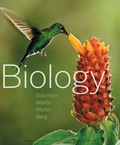
Concept explainers
The regulation of most bacterial genes occurs at the level of (a) transcription (b) translation (c) replication (d) posttranslation (e) postreplication
Introduction: Genes are sets of nucleotides that codes for a particular protein. The genes have to be expressed for the synthesis of a protein. Gene regulation is a process where the expression of genes is controlled for the synthesis of specified gene products (usually RNA or proteins). This gene expression is regulated depending on the requirement of the cell. For example, cell division proteins are synthesized prior to the cell division. Prokaryotic and eukaryotic genes have differential gene expression in order to suit the specific needs of the cell.
Answer to Problem 1TYU
Correct answer: The regulation of most bacterial genes occurs at the level of transcription.
Hence, the correct answer is option (a).
Explanation of Solution
Reason for the correct answer:
Bacterial cells are prokaryotic cells and are unicellular. Therefore, they have limited components for all its essential functions. Another reason is that they have a very short life cycle, so fewer components are synthesized. Gene expression in bacteria occurs only when the environmental conditions are favorable such as the availability of food. In prokaryotic gene regulation, the half-life of mRNA is very less in order not to accumulate many mRNA and prevent unnecessary protein synthesis. In order to produce RNA and proteins at the time of requirement only and prevent unnecessary accumulation of molecules, bacteria have transcriptional-level control as part of gene regulation. Transcriptional-level control is found to be very efficient in bacteria as it helps to regulate the genes based on requirement, and favorable environmental conditions.
Option (a) is given as “transcription”.
Bacteria have transcriptional-level control as part of gene regulation.
Hence, the correct answer is option (a).
Reasons for incorrect answers:
Option (b) is given as, “translation”.
Translation is the process of formation of the protein inside the ribosomes. The bacterial genes regulate at the transcriptional-level, not at translational-level.
Hence, option (b) is incorrect.
Option (c) is given as, “replication”.
DNA replication is the process of the synthesis of the double strand by the action of the enzyme
Hence, option (c) is incorrect.
Option (d) is given as, “posttranslation”.
The bacterial genes regulate at the transcriptional-level, not at posttranslational level.
Hence, option (d) is incorrect.
Option (e) is given as, “postreplication”.
The bacterial genes regulate at the transcriptional-level, not at postreplication level.
Hence, option (e) is incorrect.
Hence, the options (b), (c), (d), and (e) are incorrect.
Transcription is the process of the formation of the
Want to see more full solutions like this?
Chapter 14 Solutions
EBK BIOLOGY
- Noggin mutation: The mouse, one of the phenotypic consequences of Noggin mutationis mispatterning of the spinal cord, in the posterior region of the mouse embryo, suchthat in the hindlimb region the more ventral fates are lost, and the dorsal Pax3 domain isexpanded. (this experiment is not in the lectures).a. Hypothesis for why: What would be your hypothesis for why the ventral fatesare lost and dorsal fates expanded? Include in your answer the words notochord,BMP, SHH and either (or both of) surface ectoderm or lateral plate mesodermarrow_forwardNot part of a graded assignment, from a past midtermarrow_forwardNot part of a graded assignment, from a past midtermarrow_forward
- please helparrow_forwardWhat does the heavy dark line along collecting duct tell us about water reabsorption in this individual at this time? What does the heavy dark line along collecting duct tell us about ADH secretion in this individual at this time?arrow_forwardBiology grade 10 study guidearrow_forward
 Human Heredity: Principles and Issues (MindTap Co...BiologyISBN:9781305251052Author:Michael CummingsPublisher:Cengage Learning
Human Heredity: Principles and Issues (MindTap Co...BiologyISBN:9781305251052Author:Michael CummingsPublisher:Cengage Learning
 Human Biology (MindTap Course List)BiologyISBN:9781305112100Author:Cecie Starr, Beverly McMillanPublisher:Cengage Learning
Human Biology (MindTap Course List)BiologyISBN:9781305112100Author:Cecie Starr, Beverly McMillanPublisher:Cengage Learning Biology (MindTap Course List)BiologyISBN:9781337392938Author:Eldra Solomon, Charles Martin, Diana W. Martin, Linda R. BergPublisher:Cengage Learning
Biology (MindTap Course List)BiologyISBN:9781337392938Author:Eldra Solomon, Charles Martin, Diana W. Martin, Linda R. BergPublisher:Cengage Learning Biology: The Dynamic Science (MindTap Course List)BiologyISBN:9781305389892Author:Peter J. Russell, Paul E. Hertz, Beverly McMillanPublisher:Cengage Learning
Biology: The Dynamic Science (MindTap Course List)BiologyISBN:9781305389892Author:Peter J. Russell, Paul E. Hertz, Beverly McMillanPublisher:Cengage Learning Biology 2eBiologyISBN:9781947172517Author:Matthew Douglas, Jung Choi, Mary Ann ClarkPublisher:OpenStax
Biology 2eBiologyISBN:9781947172517Author:Matthew Douglas, Jung Choi, Mary Ann ClarkPublisher:OpenStax





